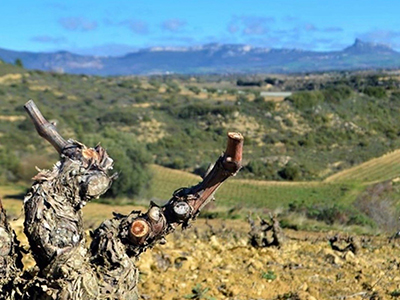Bideona
Samaniego Errepidea, km. 0, 01307, Villabuena, Álava, Spain
peninsula.wine/es/vinedos-bodegas/
A new name to follow in Rioja, Bodegas Bideona aims to bottle some of the most distinctive terroirs in Rioja Alavesa. Behind it are Basque entrepreneur and txakoli producer Gorka Izagirre and Península Viticulores, who handle the winemaking, managing and selling of Bideona wines.
Thus, the two Masters of Wine who form Península Viticultores, Andreas Kubach and Sam Harrop, replicate the model they successfully established with Fontana, the family winery of entrepreneur Jesús Cantarero in Cuenca (Castilla-La Mancha). As with Cantarero, Izagirre is now a shareholder of Península.
It all started when Gorka Izagirre purchased Bodegas Arabarte in May 2018. Located in Villabuena de Álava, the winery’s major asset were the 100 hectares of vineyards they sourced grapes from, with 300 plots on the foothills of Sierra de Cantabria in the villages of Villabuena, Leza, Samaniego, Navaridas, Laguardia and Baños de Ebro. Aged 50 years on average, many of these vines were planted in the 1920s, 1930s and 1940s, well before the arrival of clonal selection to Rioja Alavesa. This precious wine heritage is seen by Kubach and Harrop as a great asset to make wines of place instead of wines of style; wines with finesse, drinkability and the ability to age.
The working area has been extended to the north bank of the river Ebro, with traditional vineyards and limestone soils.
Badiola’s first releases start on the excellent 2018 vintage. The wines were produced in temporary premises covered by tents because the fermenting tanks at Arabarte were too big to work with the various terroirs separately. Now a new winery has been built with capacity to handle 900,000 kg of grapes.
The Burgundy-inspired range of wines is designed as a pyramid covering all categories, from entry-level cuvées to single-vineyard wines.
Labelled as Rioja Alavesa, the entry level cuvées include a white and red “vinos de zona” that retail at around €9-10. The names evoke the location of red and white grapes in traditional vineyards: Viura de Cabezadas in the case of the unoaked white (cabezada is the upper part of the vineyard) and Tempranillo de Ladera (slopes) for the red, with about one fourth of the wine aged in barrel.
The next level includes the red and the white Las Parcelas (both around €15 in Spain). Grapes are sourced from old vines planted on limestone soils. In both cases, only one fourth of the wine is aged in barrel.
Village wines (around €29 in Spain) come from traditional vineyards in the Sonsierra area, planted before the introduction of clonal selection. Because Rioja regulations required these wines to come from the same village where the winery is based, Badiola created some ingenious names to identify them. The fresh, aerial L4GD4, with its crisp red fruit, is from Laguardia; the rounder, riper V1BN4, with more presence on the mid-palate, is from Villabuena; the structured L3Z4, with its lovely acidity, ripe fruit and ageing potential, is from Leza; and the finely textured S4MG0 is from Samaniego. Now new Rioja regulations allow these wines to be identified as "Viñedo en" (vineyard in), but Badiola intends to keep the original names.
The latest development is a range of limited production single vineyard wines. The aim is to work with a dozen sites and release three to six wines a year, when they are ready to drink, regardless of the vintage. Some of these plots have been registered as 'Viñedo Singular', but Bideona does not intend to use this classification, as the winery does not agree with having to submit wines for qualification every new vintage. Production does not exceed 2,000 bottles and the wines retail for between €70 and €95.
The first single vineyards to be released are Cofrades, Leizagoia and Galtzada. Cofrades is the technical team's favourite plot in Leza due to its huge biodiversity of plant material. This is a deep, smooth wine, with a distinctly spicy character. It is aged in 500-litre barrels, like the more powerful and structured Lezagoia, sourced from four small plots planted between 1930 and 1950 in the site of the same name. Caltzada is quite different: an aerial, expressive Garnacha from Lanciego with remarkably exuberant herbal notes.
Most popular
NEWSLETTER
Join our community of Spanish wine lovers


